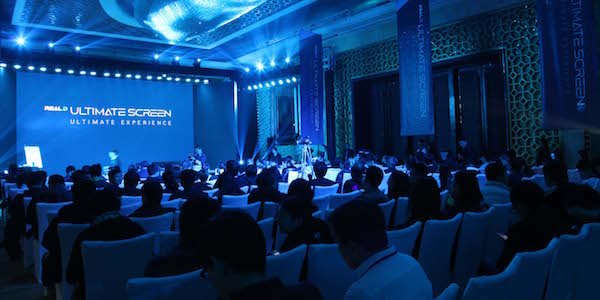RealD's Ultimate Screen Technology: What It Is, And What It Means For 3D Movies


Recently, CinemaBlend traveled to RealD's labs in Boulder, Colorado, where they introduced us to the "Ultimate Screen." Currently available in select global markets, with the intention to implement it into more movie theaters soon, the Ultimate Screen is designed to improve 3D presentation. At the basic level, the Ultimate Screen is brighter, smoother and more uniform than your traditional silver screen, producing 85% more brightness to what is presented on a "standard" screen that's currently in your local multiplex. Placed side-by-side with a standard silver screen, the matte-white Ultimate Screen makes the "silver" screen look dishwater grey. It's striking how much brighter and pure the Ultimate Screen looks.
The increased brightness and control over the image that comes with the Ultimate Screen presents a crisper, cleaner and sharper 3D display. Color uniformity stands out on the Ultimate Screen, meaning that your "blacks" are as black as you want, and your "whites" are as white as can be. We watched a handful of recent 3D trailers for movies like Star Wars: The Last Jedi, Thor: Ragnarok and A Wrinkle in Time, and while we recognize that RealD Boulder's labs likely offer the pinnacle of 3D presentation, it was the power of the image displayed on the company's Ultimate Screen that made all the difference.
What makes RealD's engineered Ultimate Screen stand out? It starts on the surface of the actual screen, which preserves the polarization that is being done at the projector and at the XL, which is RealD's trademark light-doubling technology. Standard "silver" screens currently are constructed of flakes of materials that are sprayed across the fabric, creating an uneven surface that can lead to significant light loss and depolarization. RealD knows that the best possible surface to project an image onto would be a mirror. But since you can't project a movie onto a mirror, they took the next step: They ground up mirrors into paint and coated their Ultimate Screen with it, creating a uniform, bright and mirror-like surface that reflects more light back at the audience members in the theater. From what we saw, it is superior in presentation to current "silver" screens.

Suitable for both 2D and 3D presentations, RealD's Ultimate Screen offers a stereo contrast ration of 1000:1, which instantly reduces ghosting on images (subtitles on 3D movies, for example, create all sorts of problems that are reduced or eliminated by the Ultimate Screen) and does away with "speckle" that occurs in 3D movies.
There was an unexpected, and welcome, side effect that came with the improved imagery on the Ultimate Screen: the 3D that we were being shown became far more immersive. Whether you realize it or not, blur and noise in a 3D presentation takes you out of the artificial realm meant to be constructed by a 3D movie. You start to recognize that you are, indeed, watching something as opposed to experiencing it when the 3D presentation is disrupted by technical glitches that many times can be attributed to the screen. This is yet another reason why the Ultimate Screen should be a preferred method for 3D viewing for audience members who are serious about enjoying their 3D entertainment.
The focus for rolling out Ultimate Screen has been on movie screens that service the film industry, as well as premium theaters around the world. Other locations currently employing RealD's Ultimate Screen include: L.A. Live; the AMC in Burbank, California (near Disney and Warner Bros. studios); the Surrey Quays Odeon in London; the Beijing Wanda; the Texas Cinemark in Plano; and, naturally, the Cinemark near RealD's labs in Boulder, Colorado. But as RealD continues to perfect the Ultimate Screen, the plan is to roll it out to as many locations as possible.
This revolutionary innovation makes so much sense, it's somewhat shocking that it hasn't happened sooner, and in more locations. Over the years, so many advancements in the movie industry have involved theater projectors, and the cameras that capture images (in native 3D, or at higher frame rates). Multiplexes from Washington, D.C. to San Francisco are renovating auditoriums with comfier seats, and concession stands are constantly luring patrons back to theaters with tastier treats or alcoholic beverages to spice up date night at the movies.
Your Daily Blend of Entertainment News
But when was the last time the movie screen at your preferred movie theater has been updated? Can you think of a time when it was ever changed at all? Seeing how important the physical screen is to the movie-going experience, you'd assume that more attention and care would be paid to the quality of the screen manufacturing. RealD seems to be addressing that issue (and several other 3D issues, in the process). They want to help deliver the ultimate theater-going experience. And from what we saw, the Ultimate Screen is the key.
The above article was produced as part of a sponsored trip to interact with and learn about Real D's newest technology.

Sean O’Connell is a journalist and CinemaBlend’s Managing Editor. Having been with the site since 2011, Sean interviewed myriad directors, actors and producers, and created ReelBlend, which he proudly cohosts with Jake Hamilton and Kevin McCarthy. And he's the author of RELEASE THE SNYDER CUT, the Spider-Man history book WITH GREAT POWER, and an upcoming book about Bruce Willis.
